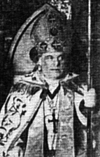
Most Reverend J. René Vilatte (1854-1929)

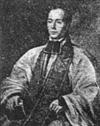 At that time in his life, he met Father
Charles Chiniquy (right) (1809-1899),
the Quebec reformer who had founded the French-Canadian Community Movement
in the United States (registered in Kankakee District Court, Illinois (1859),
under the name Christian Catholic Church). Vilatte joined Chiniquy in Montreal
and worked in his Franco-Canadian interdenominational mission movement,
under the auspices of the Presbyterian Church. He was sent to Saint Hyacinthe,
Quebec as a teacher and catechist at Saint John Church with Rev. Moïse
Boudreau, a disciple of Father Chiniquy.
At that time in his life, he met Father
Charles Chiniquy (right) (1809-1899),
the Quebec reformer who had founded the French-Canadian Community Movement
in the United States (registered in Kankakee District Court, Illinois (1859),
under the name Christian Catholic Church). Vilatte joined Chiniquy in Montreal
and worked in his Franco-Canadian interdenominational mission movement,
under the auspices of the Presbyterian Church. He was sent to Saint Hyacinthe,
Quebec as a teacher and catechist at Saint John Church with Rev. Moïse
Boudreau, a disciple of Father Chiniquy.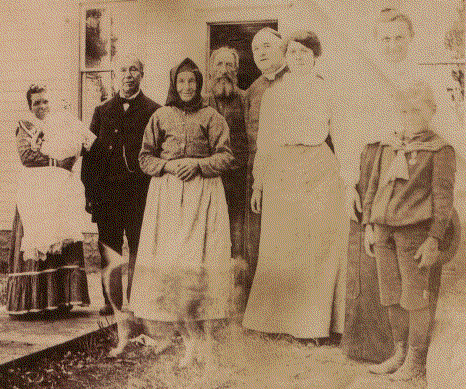 Sent to Green Bay, Wisconsin,
he worked as a lay missionary to the Belgian and French-Canadian colonies
of Brown County. Father Chiniquy went there to support his ministry and
preached in Green Bay, Fort Howard and Marineette (October 1884). At that
time Vilatte was asked to serve as pastor at Calvary French Church, Green
Bay. His talent as a preacher brought many people to the church, not only
from the Green Bay, Brown County area, but from the northern French-speaking
colonies of Door County; where an independent catholic movement had been
initiated at Desert, Wisconsin, among the Belgians. Mr. Édouard
de Bekker (right), the president of the
movement came to see Vilatte in Green bay and asked him to become their
pastor.
Sent to Green Bay, Wisconsin,
he worked as a lay missionary to the Belgian and French-Canadian colonies
of Brown County. Father Chiniquy went there to support his ministry and
preached in Green Bay, Fort Howard and Marineette (October 1884). At that
time Vilatte was asked to serve as pastor at Calvary French Church, Green
Bay. His talent as a preacher brought many people to the church, not only
from the Green Bay, Brown County area, but from the northern French-speaking
colonies of Door County; where an independent catholic movement had been
initiated at Desert, Wisconsin, among the Belgians. Mr. Édouard
de Bekker (right), the president of the
movement came to see Vilatte in Green bay and asked him to become their
pastor. 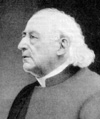 He presented the situation to Father Chiniquy
and it was felt favourable to get in touch with French reformer Hyacinthe
Loyson (left). He had been a Christian
Catholic (Old Catholic) rector in Geneva and was close to Bishop Edward
Herzog, the Swiss Bishop. He recommended Vilatte to him. Following a tutorial
training program under Bern University Professor E. Michaud, Vilatte passed
an comprehensive examination in Christian Catholic theology and was ordained
to the priesthood on June 7th. The ceremony took place in the Cathedral
of Saints Peter and Paul in Bern.
He presented the situation to Father Chiniquy
and it was felt favourable to get in touch with French reformer Hyacinthe
Loyson (left). He had been a Christian
Catholic (Old Catholic) rector in Geneva and was close to Bishop Edward
Herzog, the Swiss Bishop. He recommended Vilatte to him. Following a tutorial
training program under Bern University Professor E. Michaud, Vilatte passed
an comprehensive examination in Christian Catholic theology and was ordained
to the priesthood on June 7th. The ceremony took place in the Cathedral
of Saints Peter and Paul in Bern."Landing there, walked south along the lonely shore of Green Bay for about three miles where you will find a small house facing the bay, a log cabin clapboarded over the logs, with a crodd arising from the centre of the ridge-pole. This at once is the rectory and chapel. Its overlook is most lovely. It is entered by door in the middle of the front side. Entering the door we are in the middle of holy poverty. The seats in the chapel are rough planks resting on temporary structures, the altar construction likewise, which is concealed by plain white muslin frontal. The top is covered with fair linen cloth, the altar ornaments are made of wood by the priest himself, and their roughness concealed by a coat of paint or folds of white paper. A platform a few inches high does duty for foot pace and on the floor surrounding the altar and foot pace is tacked a strip of crash towelling. This is the chancel. The sanctuary lamp is a taper in a tumbler of oil resting on a bracket nailed to the window frame. An equally rough lectern completes the furniture. For vestments, a cheap set of white Roman pattern with a chalice and paten.
"The office and bedroom of the priest are opposite. Here there is no attempt at a credible appearance, except that as a chapel, all is scrupulously neat. In the office, a small cookstove and pine table covered with enamel cloth. Over the table is a rough shelf containing a few books, small crucifix and photographs of Bishop Edward Herzog, Père Hyacinthe Loyson and Dr. Eugene Michaud. A similar shelf in the bedroom contains a few more books. On the floor is no sight of carpet, on the bare logs of the house no coverings but whitewash" (The Living Church 10-24-1885).
At this time Marcel Pelletier joined Vilatte as a lay missionary.
(Editor's Notes : Reading the above, we see how simple Vilatte lived in his mission territory. There were few creature comforts and like many other pioneer priests, he made a sacrifice to live among and minister to the people of God in North-eastern Wisconsin. I believe that this is what Bishop Brown saw, when he visited the station. Vilatte was a humble man and many people saw this.)
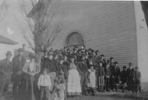 1886 Out of the mission
station grew a parish of 140 people, in only a few months, including the
Desert/Brussels congregation. The need for a larger permanent church was
felt. Between January 23 and march 22, Vilatte gathered the sum of $4,500
preaching in Chicago, New York, Boston and Baltimore. He was given a piece
of land in Gardner, a few miles from Little Sturgeon. At this location,
the Church of the Precious Blood of Jesus (right)
was started. The Episcopal Bishop of Fond du Lac, Bishop J.H. Brown, presided
at the ground breaking ceremony. Brown was supportive of Vilatte's ministry
and supported the ministry until his death in May 1888. He wrote to a colleague
in New Jersey that he regarded Vilatte and the French Canadians as "Uniats".
Part of the money gathered by Vilatte was used for the printing of catechisms
and prayer books. They were published in New York in the French language,
based on Swiss materials.
1886 Out of the mission
station grew a parish of 140 people, in only a few months, including the
Desert/Brussels congregation. The need for a larger permanent church was
felt. Between January 23 and march 22, Vilatte gathered the sum of $4,500
preaching in Chicago, New York, Boston and Baltimore. He was given a piece
of land in Gardner, a few miles from Little Sturgeon. At this location,
the Church of the Precious Blood of Jesus (right)
was started. The Episcopal Bishop of Fond du Lac, Bishop J.H. Brown, presided
at the ground breaking ceremony. Brown was supportive of Vilatte's ministry
and supported the ministry until his death in May 1888. He wrote to a colleague
in New Jersey that he regarded Vilatte and the French Canadians as "Uniats".
Part of the money gathered by Vilatte was used for the printing of catechisms
and prayer books. They were published in New York in the French language,
based on Swiss materials.
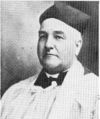 1887 Jean-Baptiste Gauthier (right), a friend and colleague of Vilatte from the
French-Canadian Chiniquist mission movement, joined him and Marcel Pelletier
in Gardner during the summer.
1887 Jean-Baptiste Gauthier (right), a friend and colleague of Vilatte from the
French-Canadian Chiniquist mission movement, joined him and Marcel Pelletier
in Gardner during the summer. 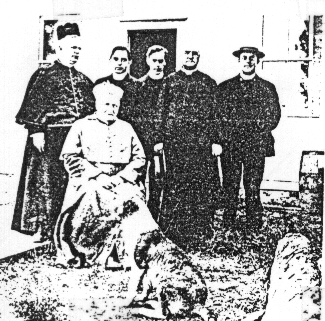 He had ministerial
training from McGill University (Presbyterian College) and had been working
as a teacher and catechist in Illinois since 1885. He was a former Christian
Brother and was teaching in Ottawa when Vilatte was in Hull, with Father
Reboul, on the Quebec side of the river. On July 7, together with Marcel
Pelletier, they formed the religious order called the Society of the
Precious Blood (left) and made it known
in a pamphlet that was published in Gardner, under the title The Society
of the Precious Blood: A Presentation. This publication brought two new
members: Henri Neville and Erasmus Proth, both admitted in the month of
October.
He had ministerial
training from McGill University (Presbyterian College) and had been working
as a teacher and catechist in Illinois since 1885. He was a former Christian
Brother and was teaching in Ottawa when Vilatte was in Hull, with Father
Reboul, on the Quebec side of the river. On July 7, together with Marcel
Pelletier, they formed the religious order called the Society of the
Precious Blood (left) and made it known
in a pamphlet that was published in Gardner, under the title The Society
of the Precious Blood: A Presentation. This publication brought two new
members: Henri Neville and Erasmus Proth, both admitted in the month of
October.
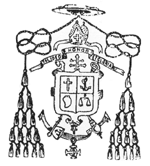 1889 Brother Gauthier was
ordained a priest in Bern and appointed pastor of Precious Blood Parish
in Gardner, at the end of October. There were about 1,000 people in the
Movement at that time: 235 in Duvall; 240 in Gardner; 40 in Menominee (Michigan),
plus a dispersion made at the following places and numbers of families:
Green Bay (5); LaGrande Baie (22); Marinette (5); Robinsonville (4); Stevenson
(5); and Valin (25). At the suggestion of Mr. Édouard de Bekker,
an assembly of clergy and delegates was held in Saint Mary's Church, Duvall,
on November 16, for the purpose of putting in place the Church structure
called for by the faith and order commonly shared by the French speaking
independent catholics. The assembly used a working document called "A
Sketch of the Belief" that had been prepared by the Society of Precious
Blood religious and had been published in Duvall on July 7 under the signature
of Vilatte, superior. It formed the basis of the "Duvall Faith &
Order Declaration" which is still observed today by some of the Old
Catholic based Canadian Churches. It was at this meeting that Vilatte was
elected to the office of Bishop.
1889 Brother Gauthier was
ordained a priest in Bern and appointed pastor of Precious Blood Parish
in Gardner, at the end of October. There were about 1,000 people in the
Movement at that time: 235 in Duvall; 240 in Gardner; 40 in Menominee (Michigan),
plus a dispersion made at the following places and numbers of families:
Green Bay (5); LaGrande Baie (22); Marinette (5); Robinsonville (4); Stevenson
(5); and Valin (25). At the suggestion of Mr. Édouard de Bekker,
an assembly of clergy and delegates was held in Saint Mary's Church, Duvall,
on November 16, for the purpose of putting in place the Church structure
called for by the faith and order commonly shared by the French speaking
independent catholics. The assembly used a working document called "A
Sketch of the Belief" that had been prepared by the Society of Precious
Blood religious and had been published in Duvall on July 7 under the signature
of Vilatte, superior. It formed the basis of the "Duvall Faith &
Order Declaration" which is still observed today by some of the Old
Catholic based Canadian Churches. It was at this meeting that Vilatte was
elected to the office of Bishop.
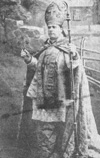 1890-1892 Support for Vilatte's
consecration came from the Independent Catholic Church of Sri Lanka, Goa
and India, through Father Bernard Harding, a priest in Roman orders who
had been a missionary there (then called Ceylon) before joining the Society
of Precious Blood in 1890. Upon his recommendation, synodal council members
were in touch with the bishops of that church and in particular, Bishop
Antonio F.X. Alverez.
1890-1892 Support for Vilatte's
consecration came from the Independent Catholic Church of Sri Lanka, Goa
and India, through Father Bernard Harding, a priest in Roman orders who
had been a missionary there (then called Ceylon) before joining the Society
of Precious Blood in 1890. Upon his recommendation, synodal council members
were in touch with the bishops of that church and in particular, Bishop
Antonio F.X. Alverez. 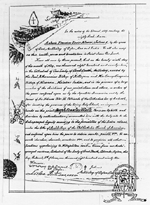 The Bishop gave
a positive answer to their request and stated that he had to consult with
the Syrian Orthodox Patriarch, Ignatius Peter III, to whom he owed his
obedience, and with his colleagues, the Syrian Malabar bishops of India.
The patriarch gave his permission for the consecration in a bull that was
issued in Mardine, on December 29, 1891, and the ceremony tool place in
the Cathedral of Our of Good Death, in Colombo, on May 29, 1892. Indian
Malabar bishops, Mar Paul Athanasius (Kottayam) and
Mar Gregorius (Niranan, India). acted as co-consecrators.
U.S. Council, William Morey acted as official witness. Returning to Wisconsin,
Vilatte established his see at Duvall and used saint Mary's as his pro-cathedral.
The Bishop gave
a positive answer to their request and stated that he had to consult with
the Syrian Orthodox Patriarch, Ignatius Peter III, to whom he owed his
obedience, and with his colleagues, the Syrian Malabar bishops of India.
The patriarch gave his permission for the consecration in a bull that was
issued in Mardine, on December 29, 1891, and the ceremony tool place in
the Cathedral of Our of Good Death, in Colombo, on May 29, 1892. Indian
Malabar bishops, Mar Paul Athanasius (Kottayam) and
Mar Gregorius (Niranan, India). acted as co-consecrators.
U.S. Council, William Morey acted as official witness. Returning to Wisconsin,
Vilatte established his see at Duvall and used saint Mary's as his pro-cathedral.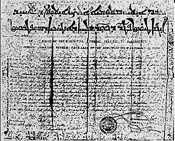 1893 Vilatte wrote and published
an Encyclical to Bishops of the Apostolic Succession, mostly to respond
to false accusations made by Bishop Grafton re: his episcopate. Opened
new parishes St Joseph in Walhaim, Kewaunee County, Wisconsin. Admitted
a new Society of Precious Blood member, Louis A. Fournier.
1893 Vilatte wrote and published
an Encyclical to Bishops of the Apostolic Succession, mostly to respond
to false accusations made by Bishop Grafton re: his episcopate. Opened
new parishes St Joseph in Walhaim, Kewaunee County, Wisconsin. Admitted
a new Society of Precious Blood member, Louis A. Fournier.
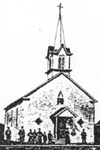 1895 The Cathedral Church of
St. Louis of France (right) was erected
and blessed in Green Bay, Wisconsin. The episcopal see was transferred
there from Duvall. Father J. Lebourt, a former Roman Catholic priest, is
admitted to the diocese and appointed pastor at Gardner.
1895 The Cathedral Church of
St. Louis of France (right) was erected
and blessed in Green Bay, Wisconsin. The episcopal see was transferred
there from Duvall. Father J. Lebourt, a former Roman Catholic priest, is
admitted to the diocese and appointed pastor at Gardner.
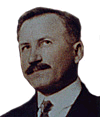 1909-1922 Back in America he ordained
to the priesthood Father Casimir F. Durand
(right) (to succeed Bishop Vilatte
as 2nd bishop ordinary of the Christian-Catholic Rite of Communuty Churches)
at the Polish Notre-Dame church in Winnipeg, Manitoba, Canada in 1909 then
in 1914 assigned him to ministry in Minneapolis, Minnesota. He established
the American Catholic Church Council, the jurisdictions and groups which
had come out of his episcopal ministry or were under his oversight. Among
them were French and English speaking constituencies, a Polish ordinariate
under Bishop S. Kaminski
and an Italian ordinariate under Bishop Paulo M.
Gulotti (Gulotti had left Italy and moved to New York City). Vilatte designed
the 'Council' based on the Faith and Order Declaration and the Episcopal
Succession of the Christian Catholic Church Rite. It was published in a
booklet form, under the name An Order for the Apostolic Reunion in America
(Chicago 1909). Vilatte also wrote the Episcopal oath that was to be adhered
to by the bishops. It later became part of the 'Council' Constitution.
1909-1922 Back in America he ordained
to the priesthood Father Casimir F. Durand
(right) (to succeed Bishop Vilatte
as 2nd bishop ordinary of the Christian-Catholic Rite of Communuty Churches)
at the Polish Notre-Dame church in Winnipeg, Manitoba, Canada in 1909 then
in 1914 assigned him to ministry in Minneapolis, Minnesota. He established
the American Catholic Church Council, the jurisdictions and groups which
had come out of his episcopal ministry or were under his oversight. Among
them were French and English speaking constituencies, a Polish ordinariate
under Bishop S. Kaminski
and an Italian ordinariate under Bishop Paulo M.
Gulotti (Gulotti had left Italy and moved to New York City). Vilatte designed
the 'Council' based on the Faith and Order Declaration and the Episcopal
Succession of the Christian Catholic Church Rite. It was published in a
booklet form, under the name An Order for the Apostolic Reunion in America
(Chicago 1909). Vilatte also wrote the Episcopal oath that was to be adhered
to by the bishops. It later became part of the 'Council' Constitution.Requiescat in pace.
May he rest in peace!